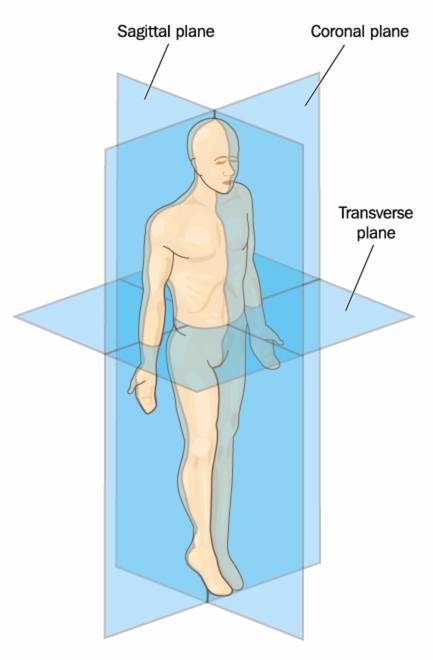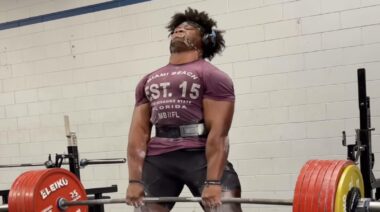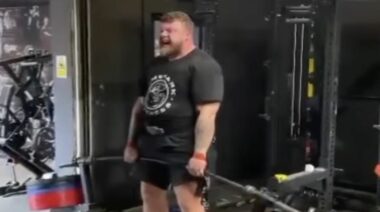While teaching lifting techniques, constant attention to detail is critical. This isn’t a new concept, but what separates great coaches from the indolent ones is constant innovation and a relentless passion for the basics. For these great coaches, improvement isn’t a life hack, it’s a campaign; a weekly, daily, and hourly fight to improve their athletes as well as themselves.
The problems we run into are viewed only as developmental opportunities, and innovation is the lynchpin for our success.
The two ideas I try to embody as a coach are to never be afraid to admit when you don’t know something, and to never fall in love with my own ideas. Instead, I fall in love with my athletes’ success. This combination drives my campaign for acquisition of knowledge while allowing me to keep an open mind. If it weren’t for this learning style, I would have never come across David Weck. David is the inventor of the BOSU ball. Prior to meeting him, I only saw the BOSU as a tool for circus tricks in the gym, so imagine my skepticism when I came across a deadlift technique from the ringleader himself.
How Deadlifts Changed Sprinting
The deadlift is commonly used in strength and conditioning programs for athletes to develop the muscles of the hip, lower back, upper back, quadriceps, hamstrings, and abdominals. They require minimal time and equipment, involve multiple joints, and work a significantly greater percentage of muscle than leg press or squats, yet accomplish the goal of large strength increases with minimal weight gain. Numerous variations are possible, by changing the type of bar (straight bar, hex bar, farmers’ bars), by adding bands or chains, or by altering the technique. If used correctly, it can be an excellent exercise to use in the development of strength, speed, and power.
Just over ten years ago, Barry Ross was the architect behind the record-breaking performances of track star Allyson Felix. Ross’s famous deadlift-based protocol was founded on a study performed by Harvard’s Peter Weyand, which determined that the key to a sprinter’s success is their relative strength; specifically, how much force he or she puts into the ground per pound of body weight. Running Speed = Stride Length x Stride Rate, and the two main factors in stride rate are turnover rate and contact time. At the time, most coaches focused solely on turnover, whereas we now know that contact time is the critical factor in stride rate.
Incorporating deadlifts allowed Ross’s athletes to produce greater mass-specific force, causing the amount of ground contact time to decrease. Getting stronger without adding bulk not only decreased ground contact time, but increased stride length without the danger of destroying good running mechanics. This innovative use of the deadlift provided the spark that Felix needed to break Marion Jones’s national high school 200-meter record, and set the stage for all future track-based strength protocols.
However, the current track athlete already has an overactive psoas from constant hip flexion, and to combine that with the lower back development of the conventional deadlift causes problems. We know without a doubt that deadlifts develop speed, but if the track athlete’s lower back hurts too much for them to perform, what is the point?
Innovation and Results
Results rule. Nothing else matters. If I couldn’t force my athletes to recover properly from weight training sessions, then a change needed to be made and my search for an innovative modification began.
Innovation is the application of better solutions to meet new requirements or unarticulated needs. This is accomplished through more-effective products, processes, services, or technologies than are readily available. The term “innovation” can be defined as something original and more effective, and as a consequence, “breaks into” the market or society. The WeckMethod Deadlift was exactly this, and I implemented it into my own training right away. Once I saw tangible results with my own training, they were immediately programmed onto my athletes’ sheets for their first quarter in school, and the real test of this new technique began.
The metrics I use to measure every new exercise are:
- Do they reduce the incidence of injury?
- Do they increase performance?
During the first quarter of the 2016 school year, the WeckMethod deadlifts accomplished both. During that quarter, my head strength coach Chris Holder and I had several Skype conversations with David to really dig in to the finer details and reasons behind his technique. After seeing the results, Chris and I knew that we had to go see David. So we traveled down to his home base in San Diego and spent two full days mining each other’s minds and training the new methods we were being taught. What we found was the beginning of a radical, Barry Ross-type change in approach to speed training.
The Spinal Engine and Speed
The inspiration and basis for modification is Serge Gracovetsky’s spinal engine theory. He believes the spine is an engine driving the pelvis, and that human anatomy is a consequence of function. Notice in this video of a subject without legs what happens during locomotion. It is obviously preferable to have legs, but they only amplify the movements of the pelvis, and their functional role remains secondary. So if the legs cannot rotate the pelvis, then what does? It has to be the spine. Many people understand how to train the “bracing core,” but few know how to optimize the “coiling core,” which is the spinal engine.
Think about your own lifting routine, and how important it is to prevent segmental motion while under load. But this is only critical for lifting weights. It isn’t really how you move best out on the field or court. In every basic biomechanics class, we are taught that muscles can only do work when in position to do so. If this is true, then why are we so reliant on preventing segmental motion, instead of causing it?
The goal of every new modification is to establish and maintain correct muscular tension throughout the body, to allow us to load the ground with more power and efficiency during athletic movement. The Head Over Foot technique was how we were going to accomplish this task. It gives you the optimal degree of side-bending and rotation, which strengthens and lengthens extension and flexion sagittally, and enables you to land each step in balance—which is the key to efficiency and power. The sequencing is:
- Side-bending in frontal plane
- Counter rotation in transverse plane
- Step forward in sagittal plane

Results Over Dogma
Since our meet up in San Diego, David, Chris, and I have been developing and testing programs with our athletes and NFL hopefuls, and couldn’t be more pleased with the initial results. The key to this innovative method’s effectiveness? Time. Implementation of the exercises we are developing takes approximately 2-3 minutes, and the results are immediate. Cementing these movement patterns will take time, but when our athletes feel the effects from a single 3-minute session, results rule.
Some of you may not trust the method, because it challenges long-held concepts of what makes people run faster, or it runs counter to what they think they see. Others may feel there is no way to adjust training to fit their athletes. From our experience, neither could be further from the truth.
Keep in mind that this campaign wouldn’t be possible if any of us were in love with our own ideas, instead of our athlete’s success. This is the genesis of a running technique that will change the way programs will be written, like the implementation of the deadlift. If you share the same passion that we have for the success of our athletes, then continue to follow us here on Breaking Muscle, as well as in the Coaches Only section.
Over the coming months, David Weck, Chris Holder, and I will continue to write about the results of our programming, and provide detailed, step-by-step processes on how to perform the exercises we have developed. Think of the times when you weren’t getting the results you were looking for, but couldn’t get out of your own way, and your athletes suffered. Results rule; and if what you’re doing isn’t working, it needs to change.
When you prioritize results, the choices make themselves:






